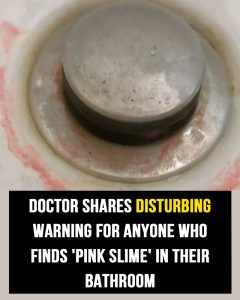In many households, a mysterious pinkish residue often appears in bathrooms, particularly around drains, on shower curtains, and in tile grout. At first glance, many people assume this discoloration is mold. However, the real culprit behind this pink slime is a bacterium known as Serratia marcescens.

This microorganism thrives in warm, moist environments and feeds on the fatty substances commonly found in soap and shampoo residues. Because bathrooms provide the perfect conditions—constant humidity, residual water, and organic matter—it’s no surprise that Serratia marcescens often makes an unwelcome appearance.
Dr. Karan Raj, a National Health Service (NHS) surgeon, has spoken about this issue, clarifying the common misconception: “If you’ve seen this pink slime lurking in your bathroom, it’s not mold—it’s bacteria.” He further explained that Serratia marcescens “loves damp, moist places and enjoys munching on fatty deposits like those found in soaps and shampoos; hence why it likes to hang out in your bathroom.”
Although it may be unsettling to discover bacterial growth in your home, Serratia marcescens is generally harmless to healthy individuals. That said, it can pose health risks to certain populations, particularly those with weakened immune systems. According to Infectious Disease Advisor, this bacterium is naturally found in various environments, including soil, water, plants, and animals. Within the home, it thrives in areas that remain wet for extended periods, such as the corners of showers or wash basins. The pinkish-red color comes from a pigment called prodigiosin, which Serratia marcescens produces.
For individuals with compromised immune systems—such as hospitalized patients, the elderly, and those with chronic illnesses—exposure to this bacterium can lead to infections in the urinary tract, respiratory system, or open wounds. These infections can be particularly difficult to treat due to the bacterium’s natural resistance to multiple antibiotics.
@dr.karanr Pink slime club @Anna ♬ original sound – Dr Karan Raj
Dr. Raj warns that while Serratia marcescens may not pose a significant threat to healthy individuals, it’s still important to be cautious: “You still want to avoid getting it in your eyes or open wounds.” Additionally, he points out that persistent dampness in bathrooms doesn’t just encourage Serratia marcescens; it also fosters the growth of other potentially harmful microorganisms, including black mold (Stachybotrys chartarum), which is known to cause serious respiratory issues.
Given these potential risks, it’s essential to take proactive steps to prevent bacterial and mold growth in the bathroom. Here are some effective strategies to keep your bathroom clean and reduce the likelihood of Serratia marcescens developing:
-
Ensure Proper Ventilation
One of the best ways to prevent bacterial and mold growth is to maintain good airflow. Always use an exhaust fan during and after showers, or open a window to reduce humidity. A dry bathroom is far less hospitable to bacteria. -
Clean Regularly with Effective Disinfectants
Consistent cleaning is crucial for keeping bacteria at bay. Use disinfectants that contain bleach or hydrogen peroxide to clean bathroom surfaces thoroughly. Pay special attention to high-risk areas such as tile grout, shower curtains, and the spaces around sinks and drains. -
Address Leaks and Standing Water Promptly
Even minor plumbing leaks can create the perfect environment for bacterial growth. If you notice a leaky faucet or pipe, fix it as soon as possible to prevent moisture buildup. -
Reduce Clutter in the Shower Area
Many people store numerous bottles of shampoo, conditioner, and body wash in their showers, but these can become breeding grounds for bacteria. Reducing the number of products in the shower and keeping them clean can help minimize bacterial growth. -
Wash Shower Curtains and Bath Mats Frequently
Shower curtains and bath mats often remain damp for long periods, making them prime locations for Serratia marcescens to grow. Washing them regularly with hot water and detergent, or using a diluted bleach solution, can help eliminate bacteria. -
Wipe Down Wet Surfaces After Use
After showering or using the sink, take a moment to wipe down wet surfaces with a squeegee or towel. Removing excess moisture can significantly reduce bacterial and mold growth. -
Use Antibacterial Cleaning Solutions in Drains
Since Serratia marcescens often accumulates around drains, periodically treating drains with a disinfectant or boiling water can help break down soap scum and kill bacteria before they spread.
By implementing these preventive measures, homeowners can significantly reduce the presence of Serratia marcescens and other harmful microorganisms in their bathrooms. A cleaner, drier bathroom not only helps prevent bacterial growth but also promotes better overall hygiene and air quality in the home.
The Key Takeaway
That pinkish residue you sometimes see in your bathroom? It’s not mold—it’s Serratia marcescens, a moisture-loving bacterium that thrives in damp environments. While it’s generally harmless for most people, it can pose a health risk to those with weakened immune systems.
By maintaining a clean and dry bathroom environment, you can prevent its growth and avoid potential health hazards. So the next time you spot pink slime near your sink or shower, don’t panic—just clean it thoroughly and take steps to prevent its return.
Did you already know about the potential dangers of pink slime in bathrooms? If not, now you do—and you have all the tools to keep your bathroom clean and bacteria-free.





